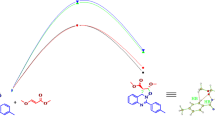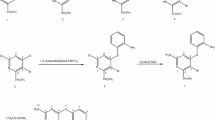Abstract
The Leuckart–Wallach reductive amination reaction in clandestine amphetamine synthesis is the most popular, simple, rapid, and safe non-metal reduction route, in which its mechanism is not known with certainty. The Minnesota 2006 exchange correlation functional M06-2X in conjugation with aug-cc-pVTZ basis set and SMD universal solvation model have been used to elucidate the kinetics and mechanism of the Leuckart–Wallach reaction for the formation of amphetamine via a five-step pathway mechanism in 1-butanol and benzene solvents. The unimolecular and bimolecular rate constants were calculated at the experimentally employed temperature 403.15 K using canonical transition state theory corrected by the quantum tunneling factors. The overall reaction is thermodynamically spontaneous and kinetically second order (first order in ammonium formate and first order in phenyl-2-propane) which is in agreement with experimental results. In the following, drug–DNA interaction in four different models has been studied in the water solvent using the mPW1B95/6–31G* level of theory. The mPW1B95/6–31G* energies were corrected for the basis set superposition error and the underestimation of London dispersion interactions by adding the gCP and D3(BJ) correction terms, respectively. According to the interaction energies, topological analysis of electron localization function and localized orbital locator, interaction of amphetamine with GpC·CpG base-pair step of DNA is non-covalent in nature. Non-covalent interaction index plots indicated that there are weak van der Waals and strong stabilizing hydrogen bond attractions between the drug and DNA. The presence of strong stabilizing hydrogen bond attractions is the responsible for the higher negative interaction energies in the interaction models including hydrogen bonds between amphetamine and DNA.
Graphical abstract







Similar content being viewed by others
References
Javors MA, King TS, Ginsburg BC, Gerak LR (2015) Addiction medicine: science and practice: neurobehavioral toxicology of substances of abuse, vol 1. Springer, New York
Adamec C (2011) Understanding drugs series: amphetamines and methamphetamine. Chelsea House, An Infobase Learning Company, New York
Moore EA (2011) The amphetamine debate: the use of adderall, ritalin and related drugs for behavior modification, neuroenhancement and anti-aging purposes. McFarland & Company Inc, North Carolina
Snow O (2008) Amphetamine syntheses: overview and reference guide for professionals. Thoth Press, USA
Greene SL, Kerr F, Braitberg G (2008) Emerg Med Austral 20:391
Spiller HA, Hays HL, Aleguas A (2013) CNS Drugs 27:531
Nguyen LA, He H, Pham-Huy C (2006) Int J Biomed Sci 2:85
Edeleanu L (1887) Ber Deutsch Chem Ges 20:616
Allen A, Cantrell TS (1989) Forensic Sci Int 42:183
Wallis ES, Nagel SC (1931) J Am Chem Soc 53:2787
Braun JV, Friehmelt E (1933) Ber Dtsch Chem Ges A/B 66:684
Schrecker AW (1957) J Org Chem 22:33
Shi XX, Yao JZ, Kang L, Shen CL, Yi F (2004) J Chem Res 2004:681
Patrick TM, McBee ET, Hass HB (1946) J Am Chem Soc 68:1009
Guy M, Freeman S, Alder JF, Brandt SD (2008) Cent Eur J Chem 6:526
Collins M, Salouros H, Cawley AT, Robertson J, Heagney AC, Arenas-Queralt A (2010) Rapid Commun Mass Spectrom 24:1653
Ritter JJ, Kalish J (1948) J Am Chem Soc 70:4048
Jonson CSL, Strömberg L (1994) Forensic Sci Int 69:31
Alexander ER, Wildman RB (1948) J Am Chem Soc 70:1187
Pollard CB, Young DC (1951) J Org Chem 16:661
Webers VJ, Bruce WF (1948) J Am Chem Soc 70:1422
Crossley FS, Moore ML (1944) J Org Chem 9:529
Lukasiewicz A (1963) Tetrahedron 19:1789
Laue T, Plagens A (2006) Namen-und Schlagwort–Reaktionen der Organischen Chemie. Teubner Verlag, Wiesbaden
Mundy BP, Ellerd MG, Favaloro FG (2005) Name reactions and reagents in organic synthesis, 2nd edn. Wiley, New Jersey
Tyagi R (2008) Organic reactions: mechanism with problems. Discovery Publishing Pvt. Ltd, New Delhi
Mutter ST, Platts JA (2011) J Phys Chem A 115:11293
Churchill CDM, Wetmore SD (2009) J Phys Chem B 113:16046
Rehman SU, Sarwar T, Husain MA, Ishqi HM, Tabish M (2015) Arch Biochem Biophys 576:49
Young DC (1950) The mechanism of the Leuckart reaction. Ph. D Thesis, University of Florida
Bennun A (2012) Int J Med Biol Front 18:767
Li X, Frisch MJ (2006) J Chem Theory Comput 2:835
Zhao Y, Truhlar DG (2008) Theor Chem Acc 120:215
Zhao Y, Truhlar DG (2008) Acc Chem Res 41:157
Dunning TH Jr (1989) J Chem Phys 90:1007
Frisch MJ, Trucks GW, Schlegel HB, Scuseria GE, Robb MA, Cheeseman JR, Scalmani G, Barone V, Mennucci B, Petersson GA, Nakatsuji H, Caricato M, Li X, Hratchian HP, Izmaylov AF, Bloino J, Zheng G, Sonnenberg JL, Hada M, Ehara M, Toyota K, Fukuda R, Hasegawa J, Ishida M, Nakajima T, Honda Y, Kitao O, Nakai H, Vreven T, Montgomery JA Jr, Peralta JE, Ogliaro F, Bearpark M, Heyd JJ, Brothers E, Kudin KN, Staroverov VN, Keith T, Kobayashi R, Normand J, Raghavachari K, Rendell A, Burant JC, Iyengar SS, Tomasi J, Cossi M, Rega N, Millam JM, Klene M, Knox JE, Cross JB, Bakken V, Adamo C, Jaramillo J, Gomperts R, Stratmann RE, Yazyev O, Austin AJ, Cammi R, Pomelli C, Ochterski JW, Martin RL, Morokuma K, Zakrzewski VG, Voth GA, Salvador P, Dannenberg JJ, Dapprich S, Daniels AD, Farkas O, Foresman JB, Ortiz JV, Cioslowski J, Fox DJ (2013) Gaussian 09, Revision D.01. Gaussian, Inc., Wallingford
Zhao Y, Truhlar DG (2008) J Chem Theory Comput 4:1849
Marenich AV, Cramer CJ, Truhlar DG (2009) J Phys Chem B 113:6378
Miguel ELM, Santos CIL, Silva CM, Pliego JR Jr (2016) J Braz Chem Soc 27:2055
Connors KA (1990) Chemical kinetics: the study of reaction rates in solution. VCH Publishers, New York
Alecu IM, Zheng J, Zhao Y, Truhlar DG (2010) J Chem Theory Comput 6:2872
Wigner E (1932) Z Phys Chem Abt B 19:203
Eckart C (1930) Phys Rev 35:1303
Canneaux S, Bohr F, Henon E (2014) J Comput Chem 35:82
Brown RL (1981) J Res Natl Bur Stand 86:357
Zhao Y, Truhlar DG (2004) J Phys Chem A 108:6908
Kruse H, Grimme S (2012) J Chem Phys 136:154101
Brandenburg JG, Alessio M, Civalleri B, Peintinger MF, Bredow T, Grimme S (2013) J Phys Chem A 117:9282
Grimme S, Antony J, Ehrlich S, Krieg H (2010) J Chem Phys 132:154104
Grimme S, Ehrlich S, Goerigk L (2011) J Comput Chem 32:1456
gCP-D3 Webservice. http://wwwtc.thch.uni-bonn.de/. Accessed 12 July 2017
Becke AD, Edgecombe KE (1990) J Chem Phys 92:5397
Silvi B, Savin A (1994) Nature 371:683
Schmider HL, Becke AD (2000) J Mol Struct (THEOCHEM) 527:51
Johnson ER, Keinan S, Mori-Sánchez P, Contreras-García J, Cohen AJ, Yang W (2010) J Am Chem Soc 132:6498
Lu T, Chen F (2012) J Comput Chem 33:580
Contreras-García J, Johnson ER, Keinan S, Chaudret R, Piquemal JP, Beratan DN, Yang W (2011) J Chem Theory Comput 7:625
Author information
Authors and Affiliations
Corresponding author
Electronic supplementary material
Below is the link to the electronic supplementary material.
Rights and permissions
About this article
Cite this article
Ostovari, H., Zahedi, E., Sarvi, I. et al. Kinetic and mechanistic insight into the formation of amphetamine using the Leuckart–Wallach reaction and interaction of the drug with GpC·CpG base-pair step of DNA: a DFT study. Monatsh Chem 149, 1045–1057 (2018). https://doi.org/10.1007/s00706-018-2145-7
Received:
Accepted:
Published:
Issue Date:
DOI: https://doi.org/10.1007/s00706-018-2145-7




